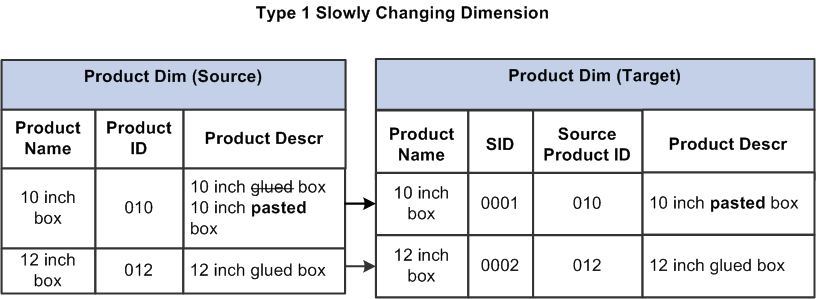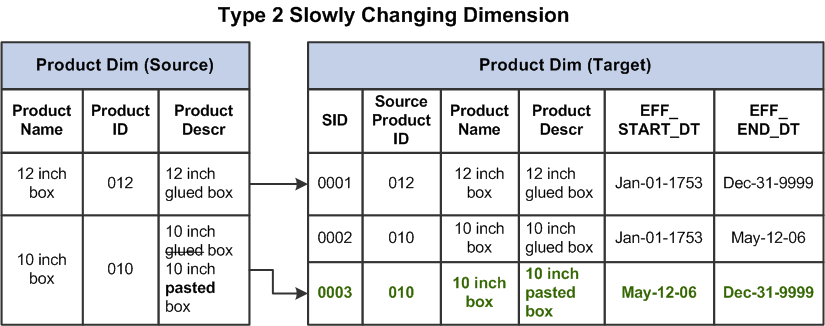Understanding Slowly Changing Dimensions
Data warehouses store historical data from an online transaction processing (OLTP) system. As new data is extracted into the data warehouse from the source OLTP system, some records may change. When the attributes of a given dimension table change, this is called a slowly changing dimension.
For example, an organization may use its Product dimension table to store product descriptions. The description lists the ingredients of the product. If there is a change to the ingredient list, the description in the OLTP is updated to reflect this change. When the changed record (the slowly changing dimension) is extracted into the data warehouse, the data warehouse updates the appropriate record with the new data. How that change is reflected in the data warehouse depends on how slowly changing dimensions has been implemented in the warehouse.
There are three types of slowly changing dimensions:
Type 1 Slowly Changing Dimension: This method overwrites the existing value with the new value and does not retain history.
Type 2 Slowly Changing Dimension: This method adds a new row for the new value and maintains the existing row for historical and reporting purposes.
Type 3 Slowly Changing Dimension: This method creates a new current value column in the existing record but also retains the original column.
Note: PeopleSoft does not support type 3 slowly changing dimensions.
Type 1 Slowly Changing Dimensions
A type 1 slowly changing dimension overwrites the existing data warehouse value with the new value coming from the OLTP system. Although the type I does not maintain history, it is the simplest and fastest way to load dimension data. Type I is used when the old value of the changed dimension is not deemed important for tracking or is an historically insignificant attribute.
For example, a company that manufactures cardboard boxes might have a Product dimension table that tracks the product ID, product name, and product description. Similar columns would be present in the warehouse Product dimension, with the addition of a surrogate ID (primary key) to track each unique record.
If one of the product descriptions were to change from glued box to pasted box in the OLTP system, it would trigger a slowly changing dimension event in the warehouse Product dimension. If you want to overwrite the former description without saving history, you would use type 1 slowly changing dimension:
Image: Type 1 slowly changing dimension
Type 1 slowly changing dimension

Note: After overwriting an existing dimension value, you may find that some of your reports that depended on the value will not return the same information as before.
Type 2 Slowly Changing Dimensions
A type 2 slowly changing dimension enables you to track the history of updates to your dimension records. When a changed record enters the warehouse, it creates a new record to store the changed data and leaves the old record intact. Type 2 is the most common type of slowly changing dimension because it enables you to track historically significant attributes. The old records point to all history prior to the latest change, and the new record maintains the most current information.
Each change to a dimension generates a new dimension record, and each record partitions history. This is done by a combination of:
Effective dating both the new and old record (the old record is assigned a non-active effective date and the new record is assigned an active effective date).
Assigning the new record a new (and unique) surrogate key.
Using the same cardboard manufacturing company as an example from the previous section, and assuming one of the product descriptions changed from glued box to pasted box in the OLTP system, type 2 slowly changing dimension would be used to retain the former description while incorporating the new. Instead of overwriting the existing value in the product description column, a new record is added, and a new surrogate ID (primary key) is assigned to the record. The original record with the description glued box remains. The following graphic demonstrates this type 2 slowly changing dimension scenario:
Image: Type 2 slowly changing dimension
Type 2 slowly changing dimension

Note that the values for source product ID and source product name columns remain unchanged, but the surrogate key values are unique for each record and the effective start and end dates indicate the current record. This distinguishes the past and current records and enables you to report on historical and current data alike.
The main drawback of type 2 slowly changing dimensions is the need to generalize the dimension key and the growth of the dimension table itself. The dimension table could become quite large in cases where there are a number of changes to the dimensional attributes that are tracked.
Type 3 Slowly Changing Dimensions
A type 3 slowly changing dimension creates a new current value column in the existing record but retains the original column as well. The new current value column holds the new dimension data coming from the OLTP system. This type of slowly changing dimension is used when a change in a dimension value must be tracked but the old value must be retained as part of the record, usually for reporting.
For example, a type 3 slowly changing dimension might be useful in a sales force realignment. When the names of the sales regions have changed but there is a need to state today's sales in terms of the past region names for comparison, a new field in the sales dimension table named current_region is added. The old field can be renamed to previous_region and no changes are made to the sales dimension record keys or to the number of sales team records. These two fields now enable an application to group all sales fact records by either the old sales assignments (previous region) or the new sales assignments (current region).
Type 3 slowly changing dimensions handle only the two most recent changes. If many changes take place and they must all be tracked, type 2 slowly changing dimensions should probably be used.
Note: PeopleSoft does not support type 3 slowly changing dimensions.